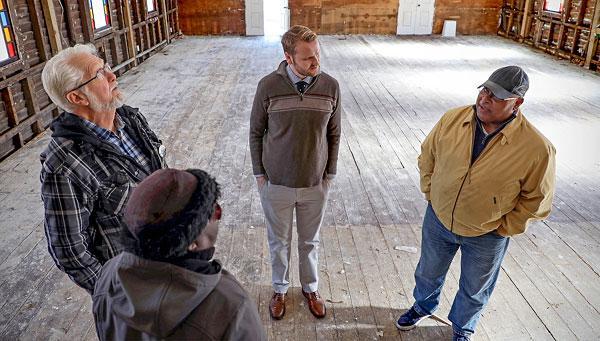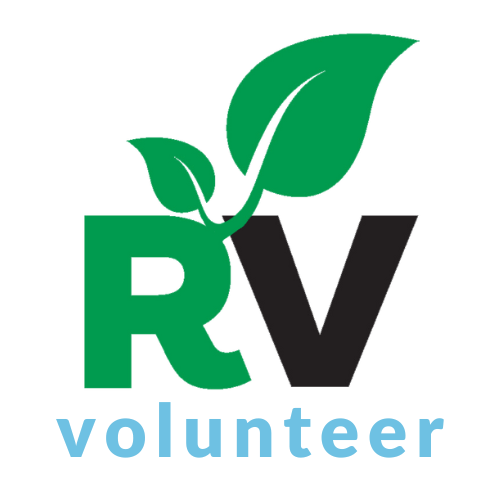Editor’s Note: Resilient Virginia invites Annual Sponsors to write guest articles for the newsletter and website. We thank Clark Nexsen, a Community Leader Annual Sponsor, for giving permission to reprint an article by Graduate Fellow, Zane Havens.
Design Thinking: How My Resiliency Fellowship Changed My Definition of a Resilient Future
by Zane Havens
When I began my one year resiliency fellowship, I expected to explore how innovative technologies could support a resilient future in coastal zones. Perhaps unavoidably, I approached my work initially with certain preconceived notions about how static structures, infrastructure, and other design methodologies could and would impact what our communities look like in 200 years.

Photograph by Aileen Devlin, courtesy of Virginia Sea Grant. As part of Zane’s research, he visited communities impacted by coastal flooding, including this Princeville, NC church that was destroyed by hurricane flooding. From left to right: Tom Duckwall, Buoyant Foundation Project; Janice Bulluck, Radicue Primitive Baptist Association; Zane Havens; and Deacon William Taylor, Radicue Primitive Baptist Association.
Today, a year later, my resiliency journey has taken me to a very different place with different views on what a resilient future looks like. My understanding of how institutional resiliency — meaning the ability of our governing institutions to adapt to disturbance through policy and changes in management practices — impacts a sustainable coastal future has evolved significantly. That’s not to say I don’t have some innovative or potentially even radical ideas about resilient design in the coastal setting — I certainly do — but I have a new awareness of and appreciation for the fact that an inevitable change is coming for coastal communities.
The simple and painful reality is that one day in the future, a migration of the general population from current coastal areas to less flood-prone, inland environments will be forced upon us. It can be hard to effectively visualize what the future looks like when it won’t impact you personally — and perhaps won’t impact your children, grandchildren, or even great-grandchildren. However, while we may not know precisely how drastic sea level rise will be and when, the recurrent and increasingly frequent nature of coastal flooding is our first clue that in 100, 150, or 200 years, our coastal communities will look very different because we will have no choice but to live a different way.
The question I’m most compelled by is how to create a “pull” factor that can incentivize migration from high-risk coastal areas to safer, more sustainable communities, and achieving this in a way that utilizes the gradual development of opportunity in elevated locations, rather than sudden coastal catastrophe, as the driver for migration.
As part of my research, I studied the forces that have driven human migration for thousands of years. Simply, large scale migration is the result of either “push” or “pull” drivers. Sea level rise is unquestionably a “push” that will grow in force and strength over the next several hundred years. The question I’m most compelled by is how to create a “pull” factor that can incentivize migration from high-risk coastal areas to safer, more sustainable communities, and achieving this in a way that utilizes the gradual development of opportunity in elevated locations, rather than sudden coastal catastrophe, as the driver for migration.
I view now as the critical time to do our best to forecast and plan a realistic journey, and then incentivize that journey. Through wise planning and development, we can create stages or phases of transition that will set future generations up for greater success and minimize disturbance and turmoil. While resilient design in its traditional sense — meaning creating structures and buildings that are resilient to the challenges of their environments — will be critical for essential coastal functions such as ports, a more realistic approach to resiliency that acknowledges the need for migration will best prepare us for the future.
A central component is shifting policy and looking at practicalities — we shouldn’t be building or developing more in certain at-risk areas. Not only because this development further reinforces the desire of the population to remain in an at-risk area, but also because more hard surfaces exacerbate flooding by reducing the amount of vegetation that can slow and absorb flood water. By building elsewhere, in more elevated locations, we can promote migration and gain a better return on our investment dollars by spending them where they will be less impacted by sea level rise, if at all.
This is not to say that a resiliency plan incorporating migration will be free of hurdles. People are tied to the place they live, whether they have been there for a year or for a century. Every community has a social footprint, a cultural identity that is tied to a particular geographic place, and those who must consider leaving that place often fear this important component of their way of life may be lost.
During my fellowship, I had the opportunity to speak with the commissioner of a small town in North Carolina that was suffering from flooding, and during a conversation on migration this issue was raised. When he was asked about whether he thought the town’s cultural heritage would be lost with a move to a safer location, his response offered hope: “We won’t lose our history. It will come with us.”
We need a dual approach — investing wisely in making the infrastructure we’ll need (ports, critical and emergency services, etc.) more resilient — while also communicating that protecting and preserving will not permanently stave off this change. We need a new way of living. My future white paper will explore this concept in greater detail, but for now I pose the central question outward — how do we form a pull driver compelling enough to draw our coastal population to safer, more resilient ground?
 Zane Havens, Resiliency Graduate, has dedicated the last year to researching coastal resiliency through a fellowship sponsored by the Virginia Sea Grant and host organization Clark Nexsen. He holds a Bachelor’s in Earth Science from Albion College and is currently pursuing a Ph.D. in Environmental Science from the University of Virginia. Beyond the earth sciences, Zane’s eclectic interests span beer distribution, marketing, and outdoor sports — he has even volunteered with a traditional Polynesian sailing canoe.
Zane Havens, Resiliency Graduate, has dedicated the last year to researching coastal resiliency through a fellowship sponsored by the Virginia Sea Grant and host organization Clark Nexsen. He holds a Bachelor’s in Earth Science from Albion College and is currently pursuing a Ph.D. in Environmental Science from the University of Virginia. Beyond the earth sciences, Zane’s eclectic interests span beer distribution, marketing, and outdoor sports — he has even volunteered with a traditional Polynesian sailing canoe.




